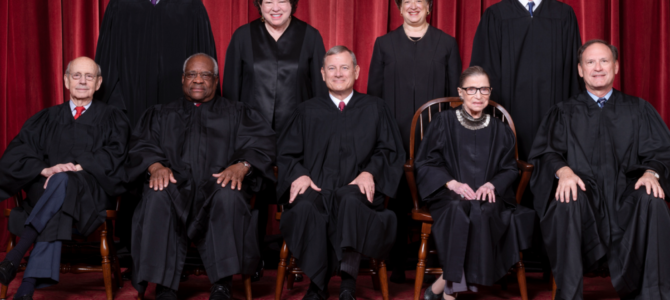
The Supreme Court ruled Monday that for defendants to be convicted of crimes, juries must decide their guilt unanimously, not by a simple majority or any other fraction. If that seems obvious, it may be because in the federal judiciary and the courts of 48 states, this is already the law and has been for a long time. Oregon and Louisiana were, until this week, the only outliers.
In applying the Sixth Amendment to the entire nation, the court ensured defendants in those two states could avail themselves of its full meaning of right. More than that, the opinion by Justice Neil Gorsuch struck a blow for originalism, the theory that the words of the Constitution should be interpreted consistent with the public understanding of them at the time they were enacted.
That he did so with the concurrence of three liberal justices (Ruth Bader Ginsburg, Stephen Breyer, and Sonia Sotomayor) and one conservative (Brett Kavanaugh) shows originalism is not just a theory to advance conservative ideas. It is a theory about how to find the truth of a thing, and how not to impose a judge’s own opinion in place of the law.
Unanimous? Or Close Enough?
The case, Ramos v. Louisiana, arose from Evangelisto Ramos’s conviction of second-degree murder in 2014. Ten jurors said they found him guilty beyond a reasonable doubt, but two believed the state had not proved its case. In almost any courtroom in America, that’s a hung jury. But in Louisiana, 10 to two was enough to convict, and Ramos was sentenced to life without parole.
He appealed, arguing the right to a trial by jury included the requirement that they must vote unanimously to convict. The Supreme Court agreed, overruling a confusing opinion from 1972 that had allowed the two states to continue their unusual practice. While any court should hesitate to overrule a prior decision, Gorsuch explained why that case, Apodaca v. Oregon, should not be accorded the same level of deference that stare decisis demands of other precedents.
Apodaca was a curiously divided opinion. Four justices held that the Sixth Amendment included unanimity. Four thought there was no such requirement. The ninth, Justice Lewis Powell, wrote a separate concurrence, holding that the Sixth Amendment did guarantee unanimity but that the 14th Amendment did not apply that requirement to state courts — a sort of halfway incorporation doctrine that had never been seen before and has never been seen since. But with five votes to allow non-unanimous jury verdicts, that non-unanimous conviction stood.
A lot of bad things came out of the 1970s, including law. The holding in Apodaca was so scattered that no view presented in the opinions actually had the support of a majority of justices. As such, it is difficult to maintain that it stands for anything outside the specific result of that one case, as the various judges’ reasonings are contradictory and impossible to reconcile with one another.
Humility Before the Law
As Gorsuch describes the reasoning of the plurality in Apodaca, the reader is struck by how bizarre it is as a method of interpreting the Constitution. The decision by Justice Byron White — for whom Gorsuch was a clerk from 1993 to 1994 — focuses its inquiry on “the function served by the jury in contemporary society.”
In 2020, Gorsuch finds it baffling that “the plurality subjected the ancient guarantee of a unanimous jury verdict to its own functionalist assessment in the first place.” Instead of a justice’s own opinion trumping all, Gorsuch eloquently calls for a humble approach to the law:
When the American people chose to enshrine that right in the Constitution, they weren’t suggesting fruitful topics for future cost-benefit analyses. They were seeking to ensure that their children’s children would enjoy the same hard-won liberty they enjoyed. As judges, it is not our role to reassess whether the right to a unanimous jury is ‘important enough’ to retain. With humility, we must accept that this right may serve purposes evading our current notice. We are entrusted to preserve and protect that liberty, not balance it away aided by no more than social statistics.
Humility is the essence of originalism. When we read any document, we interpret the words according to how they are commonly understood. That is so self-evident, it is hard to imagine doing it any other way. For older works, where the meanings of words may have changed over time, we look to see what the author meant by asking how his audience at the time would have understood it. A more strained reading of things is usually an attempt to prove a point not contained in the text, grafting the reader’s wishes onto the writer’s words.
Judges in the ’60s and ’70s often did not even bother with the strained reading, instead inventing balancing tests they thought best reflected the way the rights and benefits enshrined in the law should apply. That’s not a bad idea for the people writing the law: the legislature. But for a profession dedicated to merely interpreting the law, it is moral malpractice.
We’re All Originalists Now
How far we have come. The three most liberal justices on the Supreme Court today signed on to an opinion that is originalist to its core. Gorsuch’s historical analysis of the meaning of trial by jury in 1791 is thorough and conclusive. When the Sixth Amendment was written, “unanimous verdicts had been required for about 400 years,” Gorsuch writes. “If the term ‘trial by an impartial jury’ carried any meaning at all, it surely included a requirement as long and widely accepted as unanimity.”
Justice Clarence Thomas, writing separately as he does in cases of this sort, did his own historical analysis and found the same result. “Despite isolated 17th-century colonial practices allowing nonunanimous juries, ‘unanimity became the accepted rule during the 18th century, as Americans became more familiar with the details of English common law and adopted those details in their own colonial legal systems.’”
With three conservatives and three liberals signing on to the originalist ruling in Ramos, we see more evidence that the “living Constitution” school of thought has gone into decline. It also shows that while conservatives are the foremost practitioners of originalism, it does not guarantee conservative results.
Something that increases the rights of criminal defendants could be seen as “liberal,” but if it is liberal, then it is liberal in the original sense of the word: It promotes liberty, just as the Founding Fathers intended. In Ramos, Gorsuch shows that liberty is deeply rooted in American law and tradition, and that four or five judges should not be able to substitute their own opinions for the law of the land.









